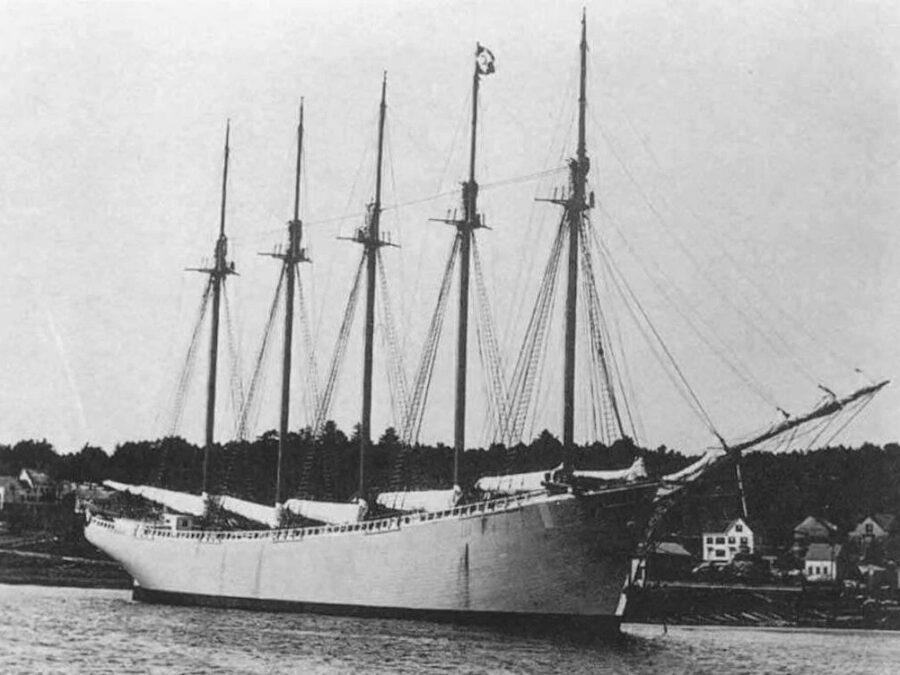
Editor’s note: The following essay is adapted from a chapter of the book by Karl Baarslag, The Coast Guard to the Rescue (New York: Farrar & Rinehart, 1937)
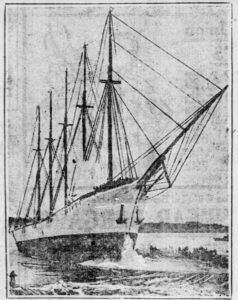
Occasionally, a ship coming ashore presents Coast Guardsmen with a perfect murder or pirate mystery. The five-masted schooner Carroll A. Deering grounded on outer Diamond Shoal in January 1921. The mystery surrounding the disappearance of her crew of 11 or 12 men has never been solved although the Department of Justice had been called in to investigate rumors of “piracy.”
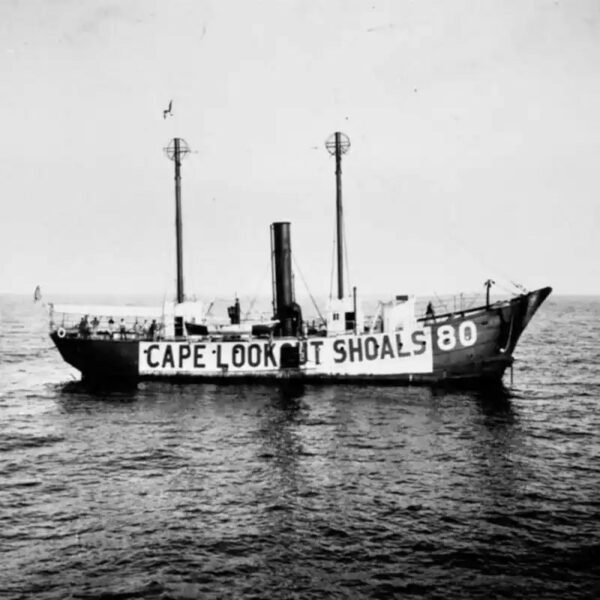
At 8 a.m. on Jan. 31, 1921, the lookout man at Hatteras Inlet Station reported a large five-masted schooner aground on the outer shoals. All sails were set but the ship, which was heading offshore, was not making any headway. Curiously, too, she flew no distress signals. The motor lifeboat was launched at 10 a.m. and the surfmen were alongside the mysterious vessel at 11:30 a.m. The schooner, evidently a new and able ship, was fast in a nest of boiling breakers, and the surfmen could approach no nearer than a quarter of a mile.
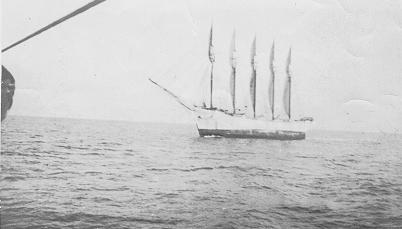
The vessel was stripped of all boats and a ladder hung over the side. The surfmen circled the schooner for nearly two hours but saw no sign of life, nor even a dog. Satisfied that the ship was unquestionably deserted, they returned to their station speculating as to what happened to the crew. No rockets, flares, or other distress signals had been seen during the night and the deserted wreck carried no signal flags to indicate trouble. Had she been abandoned offshore by her crew and then drifted ashore by herself? Had the crew hurriedly deserted the ship when it brought up in the breakers on the outer shoals only to die in the surf or to be carried offshore?

Stormy weather prevented the surfmen from revisiting the mysterious stranger until 6 a.m. on February 4. Closer approach enabled them to make out the name “Carroll A. Deering” on her stern and sideboards. The schooner was still intact and quite high out of the water. Had her crew remained aboard they would all have been saved. The lifesavers returned to their station and notified the ship’s owners. It was then learned that the Deering was a Bath-built schooner of 2,114 tons and less than a year old. She had left Rio de Janeiro the previous December bound for Norfolk via Barbados.


On February 4, Captain James Carlson of the wrecking tug Rescue boarded the mystery, which for the previous five days had been the sole topic of burning interest along the Hatteras coast. Dark and bloody tales of piracy were being noised abroad. Captain Carlson, the first man to put foot aboard the Deering, found her deep in the greedy sands off Hatteras. The deck was undulating like a serpent, and heavy seas were breeching over the wreck and sweeping through ports, doors, and companionways. Both boats were missing; the falls trailed away over the side. The wheel, rudder, rudder housing, and other gear were all smashed. Both running lights were still burning, as were two red lights in the rigging.
The wreckers carefully examined the cabins and belowdecks space and found only three half-starved cats. All the ship’s papers, nautical instruments, chronometer, as well as good clothing, were missing. However, the ship’s stores, signal flags, and other gear was still untouched and intact. Several pots were still on the stove indicating that the crew had eaten a leisurely meal of soup, spareribs, and coffee before abandoning their ship. The beds were unmade, the pots and dishes unwashed. There was no evidence of foul play nor any disturbance, though this signified very little: four days of scouring by sea and sand would have removed all traces of fight or murder. The navigating charts were found in the captain’s bathroom which lent credence to the rumor that the master had died and been buried at sea before the Deering stranded. The mate had evidently used the captain’s room and kept his charts in the bathroom.
The salvagers removed all usable sails, furniture, flags, lanterns, an expensive and well-stocked medicine chest, and all other gear. These were sold at public auction. A Bible belonging to Captain Wormel was sent to his daughter. The wreckers finally left the Deering on February 4, stripped of everything removable, and the abandoned wreck was left to brood solitude and mystery on the lonely outer shoals of Hatteras. After three weeks of pounding on the shoals, the sturdy Deering finally went to pieces.
On March 21, the cutter Seminole found the stern of the Deering 12 miles east of Hatteras. The wreckage, which consisted of the poop deck, counter, port side, afterhouse, and house deck, measured about 75 by 30 feet. The name of the mystery ship was still visible on the port bulwarks. The Seminole tried to tow the derelict into Hatteras Cove, but strong currents and northwest winds frustrated the attempt, and the wreckage was finally blown to bits using five guncotton mines and destroyed as a menace to navigation.
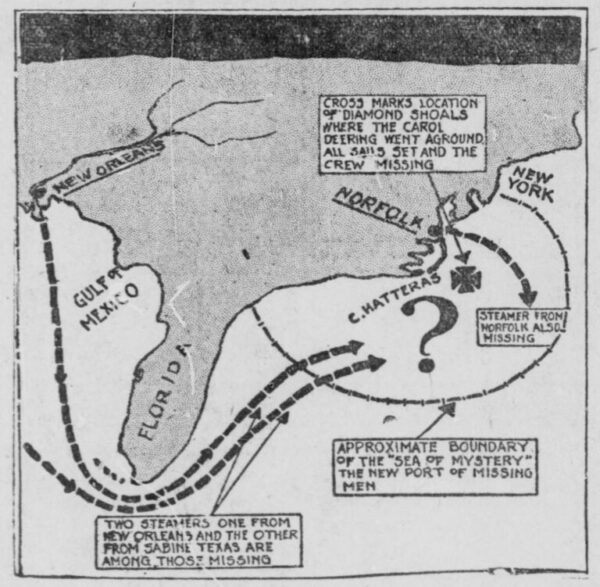
A bottle came ashore at Buxton, North Carolina, and on a soiled piece of paper was scrawled the following message:
“Deering captured by oil burning boat something like chaser. Taking off everything Handcuffing crew. Crew hiding all over ship. No chance to make escape. Finder please notify headqts. Deering.”
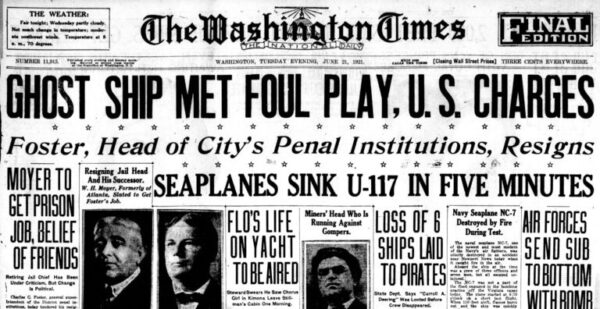
The message was forwarded to the Department of Justice. Secret Service agents went to work along the coast and months were spent running down every little clue and likely lead. Shipping registers were searched, and sailors’ boardinghouses were combed for possible leads. The “piracy” rumors persisted and would not die down.
The government men finally established that the Deering had signed on her crew at Norfolk, Virginia, for a voyage to Lewes, Delaware, and then to South America. Captain William Merritt, her master, had reported crew trouble and left the schooner at Lewes under plea of ill health. Captain Willis “Old Man” Wormel, a fine type of old shipmaster, who was practically retired, was induced to make the voyage. The Deering had gone to South America and had cleared from Rio de Janeiro for the United States. The schooner stopped at Bridgetown, Barbados, on her way to Norfolk. Captain Wormel complained to the agents about his crew and remarked that he was in poor health. The crew consisted of an American mate and engineer, a Finnish boatswain, a colored steward, and six Danish sailors. Cafe talk at Barbados recalled that the mate had threatened to “get” the old man before the ship reached Norfolk. The well-found and able schooner left Barbados for Norfolk and no human being was ever spoken again. Three deserted cats alone knew what happened to the crew of the mystery ship Carroll A. Deering.
National Coast Guard Museum insider tip: Visitors to the National Coast Guard Museum will have the opportunity to learn more about the dangers of early sea voyages, and the importance of aids to navigation in preventing groundings like the Carroll A. Deering, in Deck 4’s Champions of Commerce Wing!
